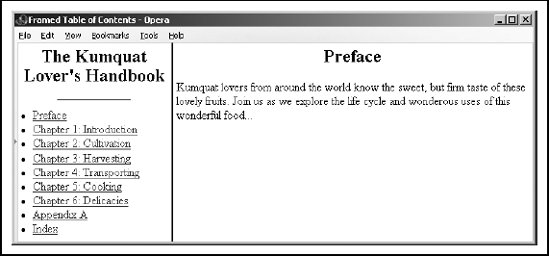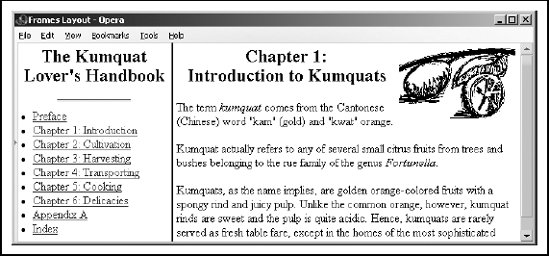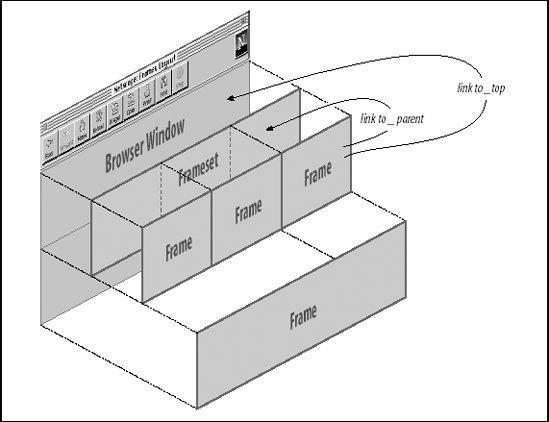Section 11.7. Named Frame or Window Targets
11.7. Named Frame or Window TargetsAs we discussed earlier in section 11.4.1, you can label a frame by adding the name attribute to its <frame> tag. [2] Once named, the frame may become the destination display window for a hyperlinked document selected within a document displayed in some other frame. You accomplish this redirection by adding the special target attribute to the anchor that references the document.
11.7.1. The target Attribute for the <a> TagIf you include a target attribute within an <a> tag, the browser loads and displays the document named in the tag's href attribute in a frame or window whose name matches the target. If the named frame or window doesn't exist, the browser opens a new window, gives it the specified label, and loads the new document into that window. Once this process has been completed, linked documents can target the new window. Targeted hyperlinks make it easy to create effective navigational tools. A simple table of contents document, for example, might redirect documents into a separate window: <h3>Table of Contents</h3> <ul> <li><a href="pref.html" target="view_window">Preface</a> <li><a href="chap1.html" target="view_window">Chapter 1</a> <li><a href="chap2.html" target="view_window">Chapter 2</a> <li><a href="chap3.html" target="view_window">Chapter 3</a> </ul> The first time the user selects one of the table-of-contents hyperlinks the browser opens a new window, labels it view_window , and displays the desired document's contents inside it. If the user selects another hyperlink from the table of contents and the view_window is still open , the browser again loads the selected document into that window, replacing the previous document. Throughout the whole process, the window containing the table of contents is accessible to the user. By clicking on a hyperlink in one window, the user causes the contents of the other window to change. Instead of opening an entirely new browser window, a more common use of target is to direct hyperlink contents to one or more frames in a <frameset> display or to an inline <iframe> window. You might place the table of contents into one frame of a two-frame document and use the adjacent frame to display the selected documents: <frameset cols="150,*"> <frame src="toc.html"> <frame src="pref.html" name="view_frame"> </frameset> When the browser initially displays the two frames, the left frame contains the table of contents, and the right frame contains the Preface (see Figure 11-6). Figure 11-6. Table of contents frame controls content of adjacent frame When a user selects a hyperlink from the table of contents in the left frame (for example, Chapter 1), the browser loads and displays the associated document into the view_frame frame on the right side (Figure 11-7). As other links get selected, the right frame's contents change, while the left frame continuously makes the table of contents available to the user. Figure 11-7. The contents of Chapter 1 are displayed in the adjacent frame 11.7.2. Special TargetsThere are four reserved target names for special document-redirection actions:
All four of these target values begin with the underscore character. The browser ignores any other window or target beginning with an underscore, so don't use the underscore as the first character of any frame name or id you define in your documents. 11.7.3. The <base> Default TargetIt can be tedious to specify a target for every hyperlink in your documents, especially when most are targeted at the same window or frame. To alleviate this problem, you can add a target attribute to the <base> tag. [<base>, 6.7.1] The target attribute in the <base> tag sets the default target for every hyperlink in the current document that does not contain an explicit target attribute. For instance, in our example table of contents document, almost every link causes the document to be displayed in another window named view_frame . Instead of including that target in each hyperlink, you should place the common target in the table of contents' <base> tag within its <head> : <head> <title>Table of Contents</title> <base target="view_frame"> </head> <body> <h3>Table of Contents</h3> <ul> <li><a href="pref.html">Preface</a></li> <li><a href="chap1.html">Chapter 1</a></li> <li><a href="chap2.html" >Chapter 2</a></li> <li><a href="chap3.html">Chapter 3</a></li> </ul> </body> Notice that we don't include any other target references in the list of hyperlinks, because the browser loads and displays all the respective documents in the base target view_frame . 11.7.4. Traditional Link BehaviorBefore the onset of frames, each time you selected a hyperlink, the corresponding document replaced the contents of the browser window. With frames, this behavior is modified so that the corresponding document replaces the content of the referencing frame. This is often not the desired behavior, and it can be disconcerting to people browsing your documents. For example, suppose you have arranged all of the documents on your site to present themselves in three frames: a navigational frame at the top of the browser window, a scrolling content frame in the middle, and a feedback form at the bottom. You named the content frame with the name attribute of the <frame> tag in the top-level document for your collection and used the target attribute of the <base> tag in every document on your site to ensure that all links are loaded into the center content frame. This arrangement works perfectly for all the documents on your site, but what happens when a user selects a link that takes him to a different site? The referenced document is still loaded into the center content frame. Now the user is confronted by a document from some other site, surrounded by your navigation and feedback frames! [3] Very impolite.
The solution is to make sure that every hyperlink that references a remote document has a target of _top . This way, when the user selects a link that takes him away from your site, the remote document replaces the contents of the entire browser window, including your navigation and feedback frames. If the majority of the links in your documents are to other sites, you might consider adding target="_top" to a <base> tag in your document and using explicit target attributes in the links to your local documents. |
EAN: 2147483647
Pages: 189
- Chapter I e-Search: A Conceptual Framework of Online Consumer Behavior
- Chapter II Information Search on the Internet: A Causal Model
- Chapter III Two Models of Online Patronage: Why Do Consumers Shop on the Internet?
- Chapter VII Objective and Perceived Complexity and Their Impacts on Internet Communication
- Chapter XVI Turning Web Surfers into Loyal Customers: Cognitive Lock-In Through Interface Design and Web Site Usability
